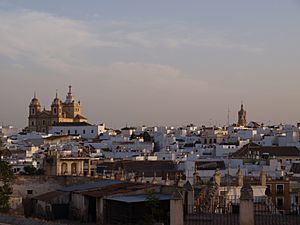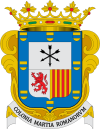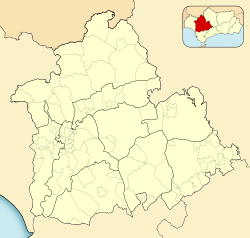Marchena, Spain facts for kids
Quick facts for kids
Marchena
|
|||
|---|---|---|---|

A view from Marchena (2016)
|
|||
|
|||
| Country | Spain | ||
| Community | Andalusia | ||
| Province | Seville | ||
| Comarca | La Campiña | ||
| Area | |||
| • Total | 378.25 km2 (146.04 sq mi) | ||
| Elevation | 150 m (490 ft) | ||
| Population
(2018)
|
|||
| • Total | 19,580 | ||
| • Density | 51.765/km2 (134.07/sq mi) | ||
| Demonym(s) | Marcheneros | ||
| Time zone | UTC+1 (CET) | ||
| • Summer (DST) | UTC+2 (CEST) | ||
| Postal code |
41620
|
||
Marchena is a town in the Province of Seville in Andalusia, Spain. Many different groups have ruled Marchena over a long time. It helps the farms around it, which grow olives and grains. It also processes olives and other farm goods. Marchena has a rich history and culture. You can visit places like the Church of San Juan Bautista, inside old Moorish walls, and the Arco de la Rosa (Arch of the Rose). The town is also famous for Flamenco music and dance. Famous artists like Pepe Marchena and Melchor de Marchena, a guitarist, were born here.
Contents
What's in a Name?
The town's old Moorish name was Marshēnah. This name means "of the olive trees."
Where is Marchena?
Marchena is in southern Spain. It is about 64 kilometers (40 miles) east of Seville. To the north are the hills of the Sierra de Horncheulos Nature Park. Cities like Cordoba, Granada, and Málaga are to the east. These cities are on the Mediterranean coast. Gibraltar is to the south.
Marchena's Landscape and Climate
Marchena sits on a flat area in the Guadalquivir Valley. It is about 131 meters (430 feet) above sea level. The weather here is like a "Mediterranean Continental" climate. This means it has cold winters and hot summers. There is also a moderate amount of rain. Summer temperatures can go over 40 degrees Celsius (104 degrees Fahrenheit). Water for the town comes from small rivers like the Corbones River.
The town covers an area of about 379 square kilometers (146 square miles). In 2006, about 19,773 people lived there. Marchena is important for farming olives, cotton, and wheat. It also has factories for canning food and greenhouses. The older part of Marchena is in the north. New parts of the town have grown to the west, south, and southeast. A railway line runs along the northern edge of the town.
Marchena's Economy
Marchena is in a farming area. Farmers here grow grains, olives, and tobacco. They also raise turkeys and chickens for eggs. There are also businesses that support farming. These include food processing factories and places where animals are prepared for meat. Marchena also makes textiles, furniture, metal, and chemical products. Other jobs are in building, hotels, and tourism.
Marchena's Past
Early People
People have lived in the Marchena area for a very long time. We know this from findings from around 3000 BCE.
Between the 8th and 7th centuries BCE, a group of Phoenicians lived near Marchena.
From about 1000 BCE, the Tartessian people lived here. They collected metals like tin and gold from the Guadalquivir River. They also brought their culture to Marchena. This might have included places for special ceremonies.
Roman Times
Around the 6th century BCE, the Carthaginians took over Seville. Products from the Marchena area were sent to Carthage. Later, in the late 3rd century BCE, the Roman Empire arrived. Roman forces led by Publius Cornelius Scipio reached Seville. The area did very well under Roman rule for many centuries. Marchena was part of the Roman province called Hispania Ulterior.
Germanic Tribes Arrive
As the Roman Empire became weaker, new groups came to Spain. In the early 5th century CE, the Vandals, Alans, and Suebi entered Spain. The Vandals took over the area where Marchena is. Then, the Visigoths also invaded Spain. They ruled from 497 CE to 711 CE. Life changed a lot under the Visigoths. The number of people went down, and farms were left empty. Towns that used to trade a lot became small forts.
Muslim Rule
From 711 CE, Muslim invaders from North Africa took over. The Visigoth Kingdom was weak. In July 712 CE, Musa bin Nusayr came with 18,000 men. He took Seville after stopping at Carmona, near Marchena. Spain became part of the larger Umayyad Caliphate. This was under Abd al-Rahman I.
During Muslim rule, Marchena was called Marsenah or "Marshana". Even with some fighting, Muslim Spain did very well. By the 12th century, Marchena was a strong town with a fortress. It had good ways of governing. It was part of the Almohad Caliphate until 1247. Then, Christian forces led by Ferdinand III of Castile took Marchena. After that, they laid siege to Seville. Some Muslims were allowed to stay, but others had to leave.
Christian Rule
Alonso Pérez de Guzmán ruled Marchena until 1309. Then, Ferdinand IV of Castile made Fernando Ponce de Leon the new ruler in 1309. Fernando's family continued to rule Marchena for many years.
In 1482, Queen Isabella I of Castile created the title "Duke of Arcos". This title was given to Rodrigo Ponce de León. He was the seventh Lord of Marchena.
Ponce de Leon Family's Influence
In the late 1400s and early 1500s, southern Spain had many sicknesses like the plague. But Marchena stayed a rich town from the 15th to the 18th centuries. This was because the Ponce de Leon family helped the town a lot.
Peninsular War
Between 1807 and 1814, Spain was in the Peninsular War. This was part of the Napoleonic wars. In 1808, Marchena formed its first group of volunteer soldiers. In 1809, General John Downie freed Marchena from the French army.
19th Century Changes
In the 1800s, Marchena and the rest of Andalusia became poorer. This happened because Spain lost its trade with its colonies. Land was also given to war heroes, and there was political trouble. In 1857, Marchena had 13,005 people. Many workers from farming towns like Marchena moved to areas with more factories.
20th Century Events
In the early 1900s, Spain had a weak military dictatorship. Then, the Spanish Constitution of 1931 was approved. But the Seville province became a center for communist and anarchist groups. In Marchena, local landowners paid for the town's branch of the Confederación Nacional del Trabajo (CNT). The CNT helped organize workers' unions. One leader of the socialist movement in the area was Mariano Moreno Mateo from Marchena. In the 1931 elections, socialist and republican parties won.
From 1936, Francisco Franco led the Bando nacional through the Spanish Civil War. He became dictator until he died. Franco made Seville his first main base. People in the area, including Marchena, who were thought to be against him were found and killed.
Historic Buildings to See
Marchena is a great place for tourists. It has many old and important buildings.
Church of San Juan Bautista
The Church of San Juan Bautista is on Calle Cristobal de Morales. It is a beautiful church built in the late 1400s. It honors John the Baptist. The church has several grand entrances. One is made of brick, and another has carved wooden decorations. These carvings show scenes from the Bible. There are also paintings by Alejo Fernandez.
Inside, the church has a Baroque style choir carved from cedar wood. This was designed by Jerónimo Balbás. You can also see sculptures by Alonzo Cano. Gold decorations were made by Francisco Alfaro.
In the church's special room, called the sacristy, there are nine paintings. These were made by Francisco de Zurbarán for the church in 1637. In 1688, Pedro de Mena y Medrano sculpted a statue of the Immaculate Conception for the church.
The church also has a museum. You can visit it by making an appointment.
Santa María de la Mota Church
The Santa María de la Mota Church was built in the 1500s. It is on the grounds of the old ducal palace. It was built in a Gothic-Mudejar style, where an old mosque used to be. The church has two different outside walls. Its tower is in the Renaissance style. Inside, the church has three main parts. Its decorations mix Christian and Islamic styles. Above the altar is a 16th-century statue of the Virgen de la Mota.
The Convent of the Immaculate Conception is also at this site. It was started by the Dukes of Arcos. Nuns from this convent make delicious sweets like pestiños borrachuelos.
San Agustín Church
The Iglesia de San Agustin was built in the late 1700s. Many artists came to Marchena during this time. For example, Manuel Salvador Carmona created the altarpiece for a group called the Brotherhood of Correa. Inside, the plaster walls have carvings of religious scenes, shapes, and plants. The church has a portico with three arches at its entrance.
San Sebastián Church
The Iglesia de San Sebastian was first built outside the palace walls as a small religious retreat. In the 1700s, it was rebuilt because it was in bad shape. The main part of the church has three sections. The main altar was built in the mid-1700s in the Baroque style. Outside, there are crosses with statues of San Sebastián and San Pablo. Inside, there is a 16th-century sculpture of the Crucified Christ. The main entrance was built in 1823.
Interesting Places to Visit
Marchena has many interesting spots for visitors.
Zurbarán Museum
This museum is named after the artist Francisco de Zurbarán. He was supported by the lords of Marchena. The museum is inside the Iglesia de San Juan Bautista. In the sacristy, there are nine of his paintings. They show the Crucifixion, the Immaculate Conception, and several saints. Zurbarán was asked to paint these in 1634 and finished them in 1637. The most famous paintings are the Immaculate Conception and the Crucifixion.
The museum also has old miniature books from the 1400s and 1500s. You can see a special black velvet robe with gold thread. There is also a rain coat embroidered with religious figures.
The church also displays gold decorations made by silversmiths like Francisco de Alfaro. These include a piece showing the Beheading of Saint John the Baptist. It is 162 cm tall and shows a temple. There is also a silver and gold cup called a chalice. It has four saints made of enamel.
Lorenzo Coullaut Valera Museum
This museum is in the Almohade Tower at the Gate of Moron. It is named after the sculptor Lorenzo Coullaut Valera. He was born in Marchena in 1876. The museum opened in 1990. It shows some of his sculptures, sketches, and copies of his works. You can see twenty-three sculptures, three reliefs, and two original drawings.
Arco de la Rosa
The Arco de la Rosa is an old gate in Marchena's ancient wall. It was built around 1430. This gate was used by travelers coming from Seville. A story says that a Moorish Princess threw roses to a Christian captain she loved. This is how the gate got its name. But the name might also come from the Madonna of the Rose.
The gate is an arch with two square columns. Above the arch is a high platform with battlements. The outside of the gate has stone shields. The original gate had a ramp, but this was changed to steps when the arch was built.
Other Places to See
Other interesting places include the Iglesia de San Miguel, Iglesia de Santo Domingo, and the Iglesia de Santa Clara. There are also the Convent of Santa Isabel, the Convent of San Andrés, and the Convent of the Immaculate Conception. Don't forget the Ducal Palace and Cilla del Cabildo.
Marchena's Culture
Holy Week Celebrations
Semana Santa (Holy Week) is celebrated in the last week of Lent. During this time, there are parades through the streets. People sing saetas, which are traditional religious songs. Good Friday morning is special for the Brotherhood of our Father Jesus of Nazareth. On Holy Saturday, people sing chants to honor the Virgin Mary.
Fairs and Festivals
Marchena's traditional fair happens on the first weekend of September. It takes place on Paradas Road. You can see casetas (display booths) and horse riders with their horses and carriages. People wear faralas (traditional frilled dresses) and enjoy performances.
Expo Marchena is a trade show for rural development. It started in 2004. The town council and local businesses work together to put it on.
Famous People from Marchena
- Jose Maria Vaca de Guzman (born 1744) was a Spanish leader, poet, and writer.
Sister Cities
Marchena has "twin towns" in other countries:
 Châteaudun, France
Châteaudun, France Esquel, Argentina
Esquel, Argentina Kronberg im Taunus, Germany
Kronberg im Taunus, Germany
See also
 In Spanish: Marchena para niños
In Spanish: Marchena para niños






